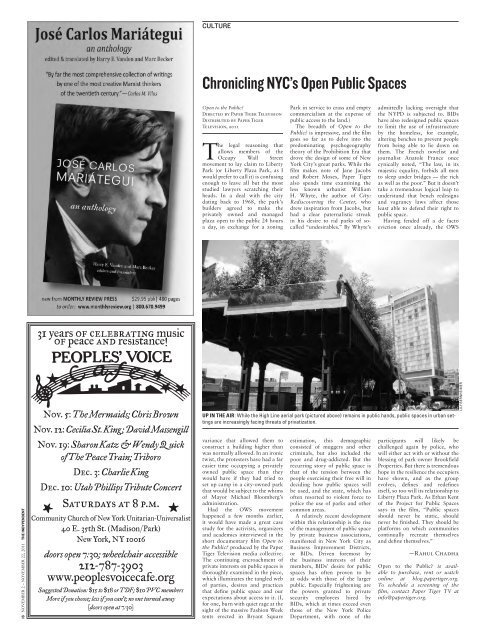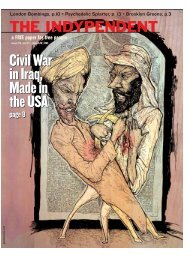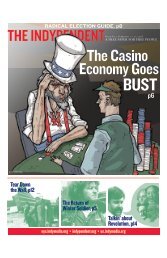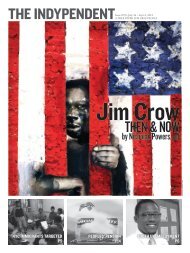MEDIATO REPRESS OR CO-OPT?OWS Media Coverage Mirrors Splits Within the 1%By Kevin YoungGandhi is often credited with saying,“First they ignore you, then theylaugh at you, then they fight you,then you win.” In just the past month, it’spossible to discern the first three responsesin the attitudes of U.S. elites toward the OccupyWall Street movement. This should bea source of great encouragement to everyoneinvolved.THE RIGHT-WING RESPONSEMany corporate elites and Republicanleaders have skipped straight to the “fighting,”or at least “worrying,” stage. In lateSeptember, one “clearly c<strong>once</strong>rned” bankCEO telephoned New York Times reporterAndrew Ross Sorkin to ask, “Is this OccupyWall Street thing a big deal?” A fewweeks later, a London banker quoted in theFinancial Times noted with alarm that theprotests “aren’t just about banks. … <strong>The</strong>y’retalking about the number of millionairesin the cabinet and all kinds of things.” Inmid-October, a Wall Street money managerinterviewed in <strong>The</strong> New York Timeslashed out against Democratic politiciansfor failing to defend Wall Street vehementlyenough, saying “<strong>The</strong>y need to understandwho their constituency is.”If a few Democrats occasionally getconfused, Republicans have no doubtsabout who their constituency is. HouseMajority Leader Eric Cantor has denounced“the growing mobs occupying Wall Street.”Mitt Romney has characterized the movementas a “dangerous” expression of “classwarfare.” Congressman Peter King was evenmore candid when speaking on a radio showOct. 7:It’s really important for us not tobe giving any legitimacy to thesepeople in the streets. … I’m takingthis seriously in that I’m old enoughto remember what happened in the1960s when the left wing took tothe streets and somehow the mediaglorified them and it ended upshaping policy. We can’t allow thatto happen.Such responses are one indicator of themovement’s power and mass appeal.THE LIBERAL END OF THECORPORATE MEDIANot all elites have the same way, however.<strong>The</strong> progression of New York Times coverageprovides a different but no less impressivemeasure of the movement’s impact.GB MARTIN<strong>The</strong> first stage, “ignoring” stage lasted alittle over a week, during which the Timesprinted just one short piece (buried onpage 22) about the Wall Street occupation.“Laughing” came next. A Sept. 25 storyin the newspaper by Ginia Bellafante, entitled“Gunning for Wall Street, with FaultyAim,” reproduced all the imagery <strong>once</strong> usedby elite commentators to try to discredit1960s social movements, arguing that OWSprotesters were “clamoring for nothing inparticular” and portraying them as psychologicaldeviants.But Times coverage has become somewhatmore honest in recent weeks. One Oct. 8blog post by Al Baker quoted a black collegeprofessor who noted that “the movementwas gaining in diversity” and who comparedOWS to the U.S. anti-slavery movement.Most surprising was an Oct. 9 editorial thatderided “the chattering classes” who “keepcomplaining that the marchers lack a clearmessage and specific policy prescriptions,”saying that “the message — and the solutions— should be obvious to anyone whohas been paying attention.” <strong>The</strong> editorialwent on to condemn the country’s historiclevels of inequality and noted that government“policy almost invariably reflects theviews of upper-income Americans.”Much press coverage continues to be dismissiveand inaccurate. But there has beena substantial shift, and that shift is anothertestament to the movement’s growing power.THEY CHANNEL YOUShifting Times coverage reflects a broadertrend among the more liberal sectors of theU.S. elite. President Barack Obama has saidpublicly that OWS “expresses the frustrationthe American people feel,” and manycongressional Democrats have made similarstatements. As a number of commentatorshave observed, Obama has tried to “channel”OWS grievances. Doing so may be politicallyrisky, however, given Democrats’allegiance to and dependence on the banksand corporations now under attack. Andmany OWS participants are very wary of theDemocratic Party. One working-class Latinaorganizer in Detroit cautions that “whilesome elites have tried to discredit OWS, wemust also be mindful of co-optation.”<strong>The</strong> classic aphorism seems simplistic:some elites will directly fight you, but otherswill try to co-opt your movement. Doug Mc-Adam, a leading scholar of the civil rightsmovement, observes in his classic bookPolitical Process and the Development ofBlack Insurgency, 1930-1970 that whilemany elites view grassroots movements asthreatening and thus try “to neutralize ordestroy” them, others see them as “an opportunityto advance their interests and thusextend cautious support to insurgents.” <strong>The</strong>Democrats are testing out the latter strategy.Although opportunistic, their responses areyet another sign of the movement’s influence.YOU WIN?<strong>The</strong>re are many additional indications of themovement’s power. Solidarity occupationshave now spread to more than 400 citiesnationwide. And a TIME magazine poll inearly October found that 54 percent of thepublic had a “favorable” view of the movement;only 23 percent had an “unfavorable”view. This sympathy toward OWS reflectswidespread outrage over inequality, corporatepower and the lack of a functioning democracyin the United States. In the samepoll, 86 percent thought that “Wall Streetand its lobbyists have too much influence inWashington,” 79 percent said that “the gapbetween rich and poor in the United Stateshas grown too large,” and 68 percent saidthat “the rich should pay more taxes.”<strong>The</strong>re are also countless personal storiesattesting to the movement’s impact. NewYork organizer Amanda Vodola spent 30hours in jail along with others who weretrying to close their accounts with Citibankduring an Oct. 15 action. Later, she describedunsanitary prison conditions andpolice officers who treated the prisonersmore like cattle than human beings. YetVodola says that the experience “made mestronger and hasn’t stopped me from wantingto continue. Being in there with a groupof powerful people definitely kept me going.It’s what keeps me going on a daily basis.”<strong>The</strong> Occupy movement is still young. <strong>The</strong>deep structural injustices associated withcorporate power won’t be rectified quickly;in this context, the practical meaningof “winning” is still unclear. Occupy WallStreet organizers will continue struggling tobuild a long-term movement that can achieveconcrete policy changes while avoiding factionalism,reformism and absorption intoinstitutionalized politics. Many organizersalso cite the need to continue diversifyingthe movement’s demographics and to “confrontthe hierarchies within the 99 percent”while still maintaining movement unity. Butdespite the challenges ahead, the range ofelite reactions, combined with the enthusiasticpublic response, provide some measureof the movement’s early effectiveness andare encouraging indicators of its potential.Kevin Young is a member of the Organizationfor a Free Society, afreesociety.org, oneof the groups helping to organize the OWSmovement.THE INDYPENDENT NOVEMBER 2 – NOVEMBER 22, 2011 15
CULTUREChronicling NYC’s Open Public SpacesOpen to the Public?Directed by Paper Tiger TelevisionDistributed by Paper TigerTelevision, 2011<strong>The</strong> legal reasoning thatallows members of theOccupy Wall Streetmovement to lay claim to LibertyPark (or Liberty Plaza Park, as Iwould prefer to call it) is confusingenough to leave all but the moststudied lawyers scratching theirheads. In a deal with the citydating back to 1968, the park’sbuilders agreed to make theprivately owned and managedplaza open to the public 24 hoursa day, in exchange for a zoningPark in service to crass and emptycommercialism at the expense ofpublic access to the land.)<strong>The</strong> breadth of Open to thePublic? is impressive, and the filmgoes so far as to delve into thepredominating psychogeographytheory of the Prohibition Era thatdrove the design of some of NewYork City’s great parks. While thefilm makes note of Jane Jacobsand Robert Moses, Paper Tigeralso spends time examining theless known urbanist WilliamH. Whyte, the author of City:Rediscovering the Center, whodrew inspiration from Jacobs, buthad a clear paternalistic streakin his desire to rid parks of socalled“undesirables.” By Whyte’sadmittedly lacking oversight thatthe NYPD is subjected to. BIDshave also redesigned public spacesto limit the use of infrastructureby the homeless, for example,altering benches to prevent peoplefrom being able to lie down onthem. <strong>The</strong> French novelist andjournalist Anatole France <strong>once</strong>cynically noted, “<strong>The</strong> law, in itsmajestic equality, forbids all mento sleep under bridges — the richas well as the poor.” But it doesn’ttake a tremendous logical leap tounderstand that bench redesignsand vagrancy laws affect thoseleast able to defend their right topublic space.Having fended off a de factoeviction <strong>once</strong> already, the OWS31 years of celebrating musicof peace and resistance!16 NOVEMBER 2 – NOVEMBER 22, 2011 THE INDYPENDENTNov. 5: <strong>The</strong> Mermaids; Chris BrownNov. 12: Cecilia St. King; David MassengillNov. 19: Sharon Katz & Wendy Q uickof <strong>The</strong> Peace Train; TriboroDec. 3: Charlie KingDec. 10: Utah Phillips Tribute C<strong>once</strong>rtSaturdays at 8 p.m.Community Church of New York Unitarian-Universalist40 E. 35th St. (Madison/Park)New York, NY 10016doors open 7:30; wheelchair accessible212-787-3903www.peoplesvoicecafe.orgSuggested Donation: $15 to $18 or TDF; $10 PVC membersMore if you choose; less if you can’t; no one turned away(doors open at 7:30)UP IN THE AIR: While the High Line aerial park (pictured above) remains in public hands, public spaces in urban settingsare increasingly facing threats of privatization.variance that allowed them toconstruct a building higher thanwas normally allowed. In an ironictwist, the protesters have had a fareasier time occupying a privatelyowned public space than theywould have if they had tried toset up camp in a city-owned parkthat would be subject to the whimsof Mayor Michael Bloomberg’sadministration.Had the OWS movementhappened a few months earlier,it would have made a great casestudy for the activists, organizersand academics interviewed in theshort documentary film Open tothe Public? produced by the PaperTiger Television media collective.<strong>The</strong> continuing encroachment ofprivate interests on public spaces isthoroughly examined in the piece,which illuminates the tangled webof parties, desires and practicesthat define public space and ourexpectations about access to it. (I,for one, burn with quiet rage at thesight of the massive Fashion Weektents erected in Bryant Squareestimation, this demographicconsisted of muggers and othercriminals, but also included thepoor and drug-addicted. But therecurring story of public space isthat of the tension between thepeople exercising their free will indeciding how public spaces willbe used, and the state, which hasoften resorted to violent force topolice the use of parks and othercommon areas.A relatively recent developmentwithin this relationship is the riseof the management of public spaceby private business associations,manifested in New York City asBusiness Improvement Districts,or BIDs. Driven foremost bythe business interests of theirmembers, BIDs’ desire for publicspaces has often proven to beat odds with those of the largerpublic. Especially frightening arethe powers granted to privatesecurity employees hired byBIDs, which at times exceed eventhose of the New York PoliceDepartment, with none of theparticipants will likely bechallenged again by police, whowill either act with or without theblessing of park owner BrookfieldProperties. But there is tremendoushope in the resilience the occupiershave shown, and as the groupevolves, defines and redefinesitself, so too will its relationship toLiberty Plaza Park. As Ethan Kentof the Project for Public Spacessays in the film, “Public spacesshould never be static, shouldnever be finished. <strong>The</strong>y should beplatforms on which communitiescontinually recreate themselvesand define themselves.”—Rahul ChadhaOpen to the Public? is availableto purchase, rent or watchonline at blog.papertiger.org.To schedule a screening of thefilm, contact Paper Tiger TV atinfo@papertiger.org.LILY BERNHEIMER












